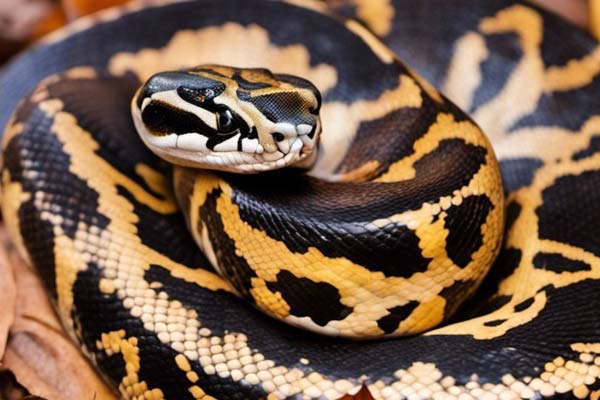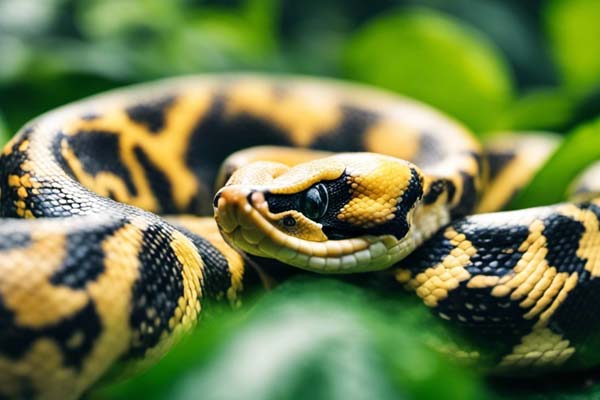Ball pythons are a popular species of pet snakes due to their docile nature, manageable size, and low maintenance requirements. However, many wonder if ball pythons are venomous and dangerous to their owners.
The answer is no; ball pythons are not venomous. They do not possess venom glands or fangs to inject venom into their prey or humans. Therefore, a bite from a ball python is not life-threatening, although it can still be painful and lead to infection if left untreated.
Remember, ball pythons can bite when scared or stressed, even though they’re not venomous. Handle them gently, respect their space, clean the wound well if they bite, and get medical help if necessary.
Understanding Venom in Snakes
Venom is a toxin injected into the victim by certain animals, including snakes. It is produced in specialized glands and delivered through fangs or other structures. Venom can affect the victim, including paralysis, tissue damage, and even death.
Not all snakes are venomous, and even among venomous species, the toxicity of the venom can vary widely. Some venomous snakes have long, hollow fangs, while others have shorter, grooved ones. The fang type and its use can affect how much venom is delivered and how quickly it acts.
On the other hand, ball pythons are non-venomous snakes and do not have fangs designed to inject venom. Instead, they have rows of small, backward-facing teeth used to grip and swallow prey. While a bite from a ball python can be painful and may cause some bleeding, it is not dangerous to humans.
It is important to note that “venomous” and “poisonous” are often used interchangeably, but they refer to different things. Venomous animals inject toxins into the victim, while poisonous animals deliver them through contact or ingestion.
For example, poison dart frogs are poisonous because their skin contains toxins that can be harmful if ingested, but they do not inject venom.
Ball Pythons: Characteristics and Behavior
Ball pythons, alternatively called royal pythons, are favored as pet snakes for their placid demeanor. Originating in Africa, they are renowned for their diverse and striking color patterns, influenced by their morph.
Regarding size, ball pythons are relatively small, with adults typically reaching 3-5 feet. They have stocky bodies, small heads, and smooth scales. When stressed, ball pythons may exhibit specific body language cues, such as curling into a ball or hissing, but they are generally relatively calm and easy to handle.
To ensure the well-being of ball pythons, creating an enclosure mirroring their natural environment is vital. This setup should include distinct warm and cool zones, a designated hiding spot, and a water dish for soaking. Maintaining the appropriate humidity is imperative by consistently misting and monitoring the enclosure.
Feeding ball pythons is distinct as they have a smaller appetite than other snake species. Typically, they eat once every 1-2 weeks, primarily consuming rodents like mice and rats. It’s worth noting that ball pythons are constrictors, utilizing constriction to suffocate their prey before ingestion.
While ball pythons are generally non-aggressive and rarely bite, handling them with care and respect is still essential. If a ball python does bite, it is typically not venomous and can be treated with proper first aid techniques.
Dispelling the Venom Myth
Despite common misconceptions, ball pythons are not venomous; instead, they are constrictors, causing the demise of their prey through suffocation. Consequently, their bites are typically not fatal.
While ball pythons are not venomous, they can still bite humans. A ball python bite can be painful and cause puncture wounds, but it is rare for a ball python to attack humans. Bites usually occur when the snake feels threatened or is defending itself.
It is important to note that ball pythons are not aggressive and will usually give warning signs before biting. They may hiss or strike with their tail as a warning sign. If a ball python does bite, it is crucial to seek medical treatment to prevent infection from bacteria in the snake’s mouth.
Hunting Techniques and Adaptations
Ball pythons are a type of constrictor snake, meaning they suffocate their prey rather than injecting venom. They use a combination of stealth, patience, and strength to catch their food. Ball pythons are known for their excellent camouflage, which allows them to blend in with their surroundings and remain hidden from potential prey.
When a ball python spots its prey, it will slowly approach and strike with lightning speed. Once it has bitten its prey, it will use its powerful muscles to wrap around the animal and squeeze it until it suffocates. Ball pythons can constrict with a force of up to 90 pounds per square inch, which is enough to crush the bones of their prey.
Ball pythons have multiple adaptations for hunting and surviving in their natural habitat. Their exceptional eyesight enables them to detect prey from afar, while their acute sense of smell aids in locating prey, even in low-light conditions. Additionally, the shedding of their skin allows them to grow and adapt to environmental changes.
Ball pythons should be fed pre-killed prey thawed and warmed to body temperature in captivity. Live prey can be dangerous for ball pythons, as they can fight back and injure the snake.
It is also essential to keep the snake’s enclosure clean and free of any scent of prey or blood, as this can trigger a feeding response and cause the snake to strike at its owner’s hand or other extremities.
Contrasting True Venomous Snakes
Ball pythons are often mistaken as venomous snakes, but they are not. Unlike true venomous snakes, ball pythons do not have fangs designed to inject venom into their prey or predators. Instead, they have small, needle-like teeth for grasping and holding onto their prey while constricting it.
When comparing ball pythons to true venomous snakes, several critical differences exist in their physical characteristics, behavior, and venom. Here is a breakdown of some of the main differences:
Fangs
True venomous snakes have specialized fangs that are hollow and can inject venom into their prey or predators. These fangs are usually located in the front of the snake’s mouth and are used for defense and hunting. In contrast, ball pythons have small, non-specialized teeth not used to inject venom.
Defense
True venomous snakes are usually more aggressive and defensive than non-venomous snakes. They will hiss, rattle their tails, and strike if they feel threatened. In contrast, ball pythons are generally docile and will try to avoid confrontation if possible.
Venom
The venom of true venomous snakes can vary significantly in its potency and effects on humans. Some venom can cause paralysis, respiratory failure, or even death. In contrast, ball pythons do not produce venom, and their bite is usually not dangerous to humans.
Predators
Venomous snakes typically occupy the apex predator position in their ecosystem, while ball pythons fall prey to larger creatures like birds of prey and other snakes.
Warning Signs
Actual venomous snakes often have warning signs such as bright colors or distinctive patterns to warn predators or prey of their venomous nature. In contrast, ball pythons do not have any warning signs and rely on their ability to hide and blend in with their surroundings for protection.

Responsible Pet Ownership and Safety
Owning a ball python can be a rewarding experience, but being a responsible pet owner is crucial to ensure the safety of both the snake and the human.
Here are some tips for responsible pet ownership and safety:
Handling: Always handle your ball python with care and caution. Do not handle them too often or for too long, as this can cause stress and discomfort for the snake. When handling, support the snake’s entire body and avoid sudden movements.
Young children: It is not recommended to have young children handle ball pythons without adult supervision. Children may not understand how to handle the snake properly, which can injure both the snake and the child.
Bite: If a ball python bites you, seek medical attention immediately. Although ball pythons are not venomous, their bites can cause harm, such as infection or bruising. Wash the bite area with soap and water, and cover it with a bandage.
Cleanliness: Regularly clean the snake’s enclosure to prevent infection and disease. Wash your hands thoroughly before and after handling the snake, and avoid touching your face or mouth.
Veterinarian: Having an experienced veterinarian for your pet snake is crucial. If your snake is injured or showing illness, seek immediate veterinary care. Depending on the seriousness of the condition, the vet may suggest antibiotics or an MRI.
Caution: Always use caution when handling a ball python. They may be docile but are still wild animals and can become stressed or agitated. Be aware of the snake’s body language and behavior, and avoid handling them if they seem uncomfortable or defensive.

